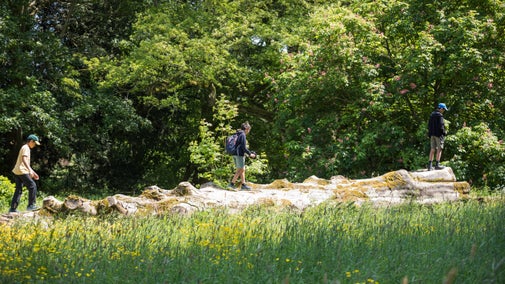
Discover more at Orford Ness National Nature Reserve
Find out when Orford Ness is open, how to get here, things to see and do and more.

Orford Ness has diverted a river, formed an estuary, created over 10 miles of coastline and over 2,000 acres of land. See the rich and varied habitats that have developed on this internationally significant nature reserve and former military testing site and spot the wildlife that makes its home here.
This part of the site was drained and levelled and used as an airfield during the First World War. Some of the reclaimed marshes were later farmed for arable crops until 1989 when they were abandoned. Since the Trust began management of the Orford Ness marshes in 1993, natural regeneration of grassland has been allowed.
The river walls have stopped salt water from flooding the marshes on normal high tides. However, due to seepage and periodic flooding, a residual salinity remains, creating a sward composition in the pastures dominated by the rough grass, sea couch. Salt marsh plants occur around the edges of the scrapes. Mowing aims to provide a variation in sward height that will encourage wading birds to breed within the open pasture areas.
On King's Marsh, the bulk of the salt water has been prevented from flooding onto the marshes. However, there is seepage, some tidal exchange, and periodic inundations from the sea when the natural shingle sea bank is overtopped.
As a result, these marshes are more saline. These marshes are managed but less intensively, and a more extensive approach is adopted to management of the wet pasture.
Kings Marsh is home to coastal brackish lagoons, a priority habitat in the EC Habitats Directive and a key habitat within the UK and Suffolk Biodiversity Action Plans (BAPs). They support a small but significant group of unusual plants and animals, including the starlet sea anemone (Nematostella vectensis), a species within the UK BAP.
Shingle is a mobile and transient habitat, rarely stable in the long term, and many of the world's shingle features are bare of vegetation. In Suffolk there are 859 hectares of vegetated shingle, about 20 per cent of the national resource. Orford Ness is the largest vegetated shingle spit in Europe and the second largest, but best-preserved, area of vegetated shingle in Britain.
The shingle ridges and valleys evident on Orford Ness have been deposited over many centuries by the action of the sea. The ridges are a visual record of the evolution of this complex landform, with each ridge showing the position of an ancient shoreline.
Unlike the growth rings of a tree, shingle ridges don't necessarily show a progressive sequence of time. In many places an older series of ridges has been destroyed and replaced by a new series. The date of formation of Orford Ness is therefore still unknown.
Reed-bed communities are relatively scarce on Orford Ness. In late 1997, under an EU LIFE-Nature project, one site was extended by two hectares.
Since the work was completed the areas of reed have expanded, and the new habitat is benefiting, with marsh harriers and bearded tits, as well as many invertebrate species, having been seen. Marsh harriers have bred and successfully raised broods on this site since 1999.
Found on John Norden's map of 1600 and named Stone Eye, this tidal creek, which joins the River Ore about a mile downstream, is wide and shallow and at low tide an expanse of mud is exposed with only a tiny tidal channel.
The mud provides excellent feeding for many hundreds of waders and wildfowl and is one of the most productive ecosystems. At the edges of the creek are areas of salt marsh, providing valuable feeding and roosting areas for large numbers of overwintering wildfowl.
Within a salt marsh the type of plant species found changes from the high to low water marks, according to the length of time each area of the marsh is covered with salt water. More species occur at the uppermost edge of the marshes, where they're exposed to salt water for a shorter time. Most salt marsh plants flower in late summer or autumn.

Orford Ness is now home to a colony of grey seals, thought to be the first in Suffolk.
The first 200 adult seals arrived on the seaward side of the site in 2021. Since then, numbers have steadily increased, with over 130 pups counted during the most recent pupping season, which started in November 2023.
Orford Ness has so far proved an ideal habitat for the colony thanks to its remote location. Due to the complex nature of the site, there is little wildlife disturbance and no direct visitor access. The 10-mile shingle spit, which is the largest in Europe, also provides them with lots of places to move inland during bad weather.
To help protect the colony, we’re asking people to refrain from visiting out of season and to clarify that there are no public permissions in place for using drones or other aerial equipment.
We will be looking at what options we have in terms of possible seal viewing routes or guided tours in the future, but at the moment, the safety of our visitors and the wellbeing of the seals is our top priority.

Find out when Orford Ness is open, how to get here, things to see and do and more.
Find out what you'll discover inside the many fascinating military buildings you'll see as you walk through Orford Ness.

From a military testing site to an internationally significant nature reserve, discover the history of Orford Ness from the 16th century to the present day.

Orford Ness is now open for the 2025 visitor season. This page explains more about how you can book a place and what to expect on your visit.

Discover the ways you can explore Orford Ness National Nature Reserve as a group, from guided walking tours to special interest visits, plus information about how to book.

Plan a visit to one of the special countryside places in our care and discover the benefits of being in the great outdoors. Pack your walking boots and get ready to explore woodlands, valleys and rivers.

Explore the varied landscape of Suffolk, including heathland, an Anglo-Saxon burial ground and scenery made famous by the landscape artist John Constable.

Explore some of the finest landscapes in our care on coastal paths, accessible trails, woodland walks and everything in between. Find the best places to walk near you.
